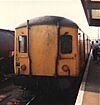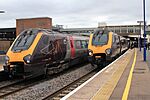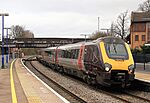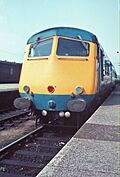List of British Rail diesel multiple unit classes facts for kids
A diesel multiple unit (often called a DMU) is a type of train that runs on diesel fuel and has its own engine and power system built right into the passenger cars. This means it doesn't need a separate locomotive to pull it. DMUs are often used for local and regional train services.
This article lists the different types, or "classes," of diesel multiple unit trains that have been used on British railways.
Contents
Early Diesel Trains
Before British Rail was formed in 1948, some railway companies were already experimenting with diesel trains. These early designs helped pave the way for the many DMUs that would come later.
First Generation DMUs (The Originals)
The first big wave of DMUs was built by British Rail starting in the 1950s. These trains were designed to replace older steam trains on many routes, especially on lines with fewer passengers.
Early BR Lightweight Trains (79xxx series)
These were some of the very first DMUs built by British Rail. They were called "lightweight" because they were designed to be lighter and more fuel-efficient than steam trains.
| Train Name | Built | Number Made | Notes | Image |
|---|---|---|---|---|
| Derby 'Lightweight' | 1954-1959 | 217 vehicles | Some were used for special railway jobs until the 1990s. |  |
| Metro-Cammell 'Lightweight' | 1955-1956 | 36 sets | A few survived for railway use until 1981. |  |
| AC Cars Railbuses | 1958 | 5 | These were small, bus-like trains. |  |
| Bristol-ECW Railbuses | 1958 | 2 | ||
| Park Royal Railbuses | 1958 | 5 | ||
| Waggon and Maschinenbau Railbuses | 1958 | 5 |  |
|
| Wickham Railbuses | 1958 | 6 | One was used for checking tracks until 1997. |  |
TOPS Classes (The Numbered Trains)
TOPS stands for "Total Operations Processing System." It's a computer system that British Rail used to give every train a special number, or "class," to help manage them. This system is still used today!
| Class | Manufacturer | Built | Number Made | Notes | Image |
|---|---|---|---|---|---|
| Class 100 | Gloucester RC&W | 1957–1958 | 40 sets | Some were used for special purposes like spraying weedkiller. |  |
| Class 101 | Metro-Cammell | 1956–1960 | 527 sets | Some lasted in railway service until 2012. |  |
| Class 102 | Metro-Cammell | 1956–1960 | 106 sets |  |
|
| Class 103 | Park Royal | 1957 | 20 sets | A few cars were used for railway jobs until 1990. |  |
| Class 104 | Birmingham RC&W | 1957–1959 | 302 cars |  |
|
| Class 105 | Cravens | 1956–1959 | 302 cars | Some were used for railway jobs until 1990. |  |
| Class 106 | Cravens | 1956–1959 | |||
| Class 107 | BR Derby 'Heavyweight' | 1960 | 26 sets | Some were used for spreading sand on tracks until 1995. |  |
| Class 108 | BR Derby 'Heavyweight' | 1958–1961 | 333 cars |  |
|
| Class 109 | D Wickham & Co | 1957–1958 | 5 sets |  |
|
| Class 110 | Birmingham RC&W 'Calder Valley' | 1961–1962 | 30 sets |  |
|
| Class 111 | Metro-Cammell | 1957–1960 | 23 sets | The last unpowered car was removed from service in 2000. |  |
| Class 112 | Cravens | 1959–1960 | 25 sets |  |
|
| Class 113 | Cravens | 1959–1960 | 25 sets |  |
|
| Class 114 | BR Derby 'Heavyweight' | 1956–1957 | 50 sets | Two cars were used as a special test unit until 2004. |  |
| Class 115 | BR Derby 'Suburban' | 1960 | 41 four-car sets |  |
|
| Class 116 | BR Derby 'Suburban' | 1957–1961 | 310 cars | Two were changed into Class 130 trains. |  |
| Class 117 | Pressed Steel 'Suburban' | 1959–1961 | 123 cars |  |
|
| Class 118 | Birmingham RC&W 'Suburban' | 1960 | 15 sets |  |
|
| Class 119 | Gloucester RC&W 'Cross-Country' | 1958 | 84 cars |  |
|
| Class 120 | BR Swindon 'Cross-Country' | 1958 | 194 cars |  |
|
| Class 121 | Pressed Steel 'Bubble Car' | 1960–1961 | 26 | This was the last first-generation DMU to be used regularly. |  |
| Class 122 | Gloucester RC&W 'Bubble Car' | 1959 | 29 | Four were used for railway jobs until 2011. |  |
| Class 123 | BR Swindon 'Intercity' | 1963 | 40 |  |
|
| Class 124 | BR Swindon 'Trans-Pennine' | 1960 | 8 six-car sets |  |
|
| Class 125 | BR Derby 'Lea Valley' | 1958 | 20 three-car sets | Some were used for fire tests until 1988. |  |
| Class 126 | BR Swindon 'Intercity' | 1959 | 22 |  |
|
| Class 127 | BR Derby 'Bed-Pan' | 1959 | 30 sets | 22 trains were rebuilt in 1985. |  |
| Class 128 | Gloucester RC&W 'Parcels' | 1959–1960 | 10 | These trains were designed to carry parcels, not passengers. |  |
| Class 129 | Cravens 'Parcels' | 1955 | 3 | One car was used for railway jobs until 1986. | |
| Class 130 | Converted from Class 116 | 1969 (converted) | 2 | These were passenger trains changed to carry parcels. |  |
| Class 131 | Converted from Class 122 | 1966, 1969, 1971 (converted) | 3 | These were also passenger trains changed to carry parcels. |
Second Generation DMUs (Modern Era)
The second generation of DMUs started being built from the late 1970s onwards. These trains were more modern, faster, and more comfortable than the first generation.
Lightweight Railcars
These are very light trains, often used on quieter lines.
| Class | Manufacturer | Built | Number Made | Still in Use? | Image |
|---|---|---|---|---|---|
| Class 139 | Parry People Movers | 2008 | 2 single cars | Yes |  |
Pacers (Bus-like Trains)
Pacers were a special type of lightweight DMU built using bus body parts. They were designed to be cheap and quick to build, often used on local routes.
| Class | Manufacturer | Built | Number Made | Still in Use? | Image |
|---|---|---|---|---|---|
| Leyland Prototypes | BREL-Leyland | 1978-84 | 4 single cars | No |  |
| Class 140 | BREL-Leyland | 1980 | 1 two-car set | No |  |
| Class 141 | BREL-Leyland | 1984 | 20 two-car sets | No (some used in Iran) |  |
| Class 142 | BREL-Leyland | 1985-87 | 96 two-car sets | No |  |
| Class 143 | Barclay-Alexander | 1985-86 | 25 two-car sets | No |  |
| Class 144 | BREL-Alexander | 1986-87 | 13 two-car and 10 three-car sets | No |  |
Sprinters (Faster Regional Trains)
Sprinters were designed to be more comfortable and faster than Pacers, used for longer regional journeys.
| Class | Manufacturer | Built | Number Made | Still in Use? | Image |
|---|---|---|---|---|---|
| Class 150 Sprinter | BREL | 1984–7 | 135 two-car and 2 three-car sets | Yes |  |
| Class 151 | Metro-Cammell | 1985 | 2 three-car units | No |  |
| Class 153 Super Sprinter | BREL-Leyland | 1991–2 | 70 single cars (converted from Class 155s) | Yes |  |
| Class 155 Super Sprinter | BREL-Leyland | 1987–8 | 42 two-car sets | Yes |  |
| Class 156 Super Sprinter | Metro-Cammell | 1987–9 | 114 two-car sets | Yes |  |
| Class 158 Express Sprinter | BREL | 1989–92 | 165 two-car and 17 three-car sets | Yes |  |
| Class 159 South Western Turbo | BREL | 1992–3 | 22 three-car sets | Yes |  |
Turbos (Modern DMUs)
"Turbo" DMUs are known for their powerful engines and smooth rides. They are used for various services, from local to express routes.
Networker Turbos
| Class | Manufacturer | Built | Number Made | Still in Use? | Image |
|---|---|---|---|---|---|
| Class 165 Networker Turbo | BREL/ABB York | 1990–2 | 49 two-car and 26 three-car sets | Yes |  |
| Class 166 Networker Turbo Express | BREL/ABB York | 1992–3 | 21 three-car sets | Yes |  |
Turbostars
| Class | Manufacturer | Built | Number Made | Still in Use? | Image |
|---|---|---|---|---|---|
| Class 168 Clubman | Adtranz/Bombardier, Derby | 1998–2004 | 9 three-car and 10 four-car sets | Yes |  |
| Class 170 Turbostar | Adtranz/Bombardier, Derby | 1998–2005 | 44 two-car and 89 three-car sets | Yes |  |
| Class 171 Turbostar | Bombardier, Derby | 2003–04 | 9 two-car and 6 four-car sets | Yes |  |
| Class 172 Turbostar | Bombardier, Derby | 2010–11 | 24 two-car and 15 three-car sets | Yes |  |
Coradias
These trains are built by Alstom and are known for their modern design.
| Class | Manufacturer | Built | Number Made | Still in Use? | Image |
|---|---|---|---|---|---|
| Class 175 Coradia | Alstom, Washwood Heath | 1999–2001 | 11 two-car and 16 three-car sets | No (withdrawn in 2023) |  |
| Class 180 Adelante | Alstom, Washwood Heath | 2000–01 | 13 five-car sets and 1 four-car set | Yes |  |
Desiro
Desiro trains are built by Siemens and are used for various services across the UK.
| Class | Manufacturer | Built | Number Made | Still in Use? | Image |
|---|---|---|---|---|---|
| Class 185 Desiro | Siemens | 2005–06 | 51 three-car sets | Yes |  |
Civity
Civity trains are built by CAF and are some of the newest DMUs on British railways.
Diesel-Electric Multiple Units (DEMUs)
DEMUs are special because they use a diesel engine to generate electricity, which then powers electric motors to move the train. This is different from a regular DMU where the diesel engine directly powers the wheels.
Southern Region DEMUs
These DEMUs were mainly used in the Southern Region of British Rail.
| Class | Built | Number Made | Still in Use? | Image |
|---|---|---|---|---|
| Class 201 | 1957-58 | 7 six-car sets | No |  |
| Class 202 | 1957-58 | 9 six-car sets | No |  |
| Class 203 | 1958 | 7 six-car sets | No |  |
| Class 204 | 1957 | 4 three-car sets | No |  |
| Class 205 | 1957-62 | 4 two-car and 29 three-car sets | No |  |
| Class 206 | 1964 | 6 three-car sets | No |  |
| Class 207 | 1962 | 19 three-car sets | No |  |
Second Generation DEMUs
These are more modern DEMUs, including some that have been converted from other types of trains.
| Class | Manufacturer | Built | Number Made | Still in Use? | Notes | Image |
|---|---|---|---|---|---|---|
| Class 210 | BREL, Derby | 1982 | 1 three-car and 1 four-car set | No | Most were scrapped, but some parts were used for other trains. |  |
| Class 230 D-Train | Metro-Cammell (original) Vivarail (conversion) |
2015 (prototype) | 1 three-car (prototype), 3 two-car, 5 three-car | Yes | These trains were made by converting old London Underground trains! |  |
| Class 231 FLIRT | Stadler | 2021-22 | 11 four-car sets | Yes |  |
|
| Class 769 Flex | BREL, York Brush Traction (conversion) |
2017 | 35 four-car sets | Yes | These were converted from electric trains (Class 319 EMUs). |  |
Voyager-style Express DEMUs
These trains are known for being fast and comfortable, used for long-distance express services.
| Class | Manufacturer | Built | Number Made | Still in Use? | Image |
|---|---|---|---|---|---|
| Class 220 Voyager | Bombardier, Bruges, Belgium | 2000-01 | 34 four-car sets | Yes |  |
| Class 221 Super Voyager | Bombardier, Bruges, Belgium | 2001-02 | 4 four-car and 40 five-car sets | Yes |  |
| Class 222 Meridian/Pioneer | Bombardier, Bruges, Belgium | 2003–05 | 4 four-car, 7 nine-car and 17 five-car sets | Yes |  |
High-Speed Trains (HSTs)
High-Speed Trains are designed for very fast journeys between major cities. They are some of the most famous trains in Britain.
| Class | Manufacturer | Information | Built | Number Made | Still in Use? | Image | |
|---|---|---|---|---|---|---|---|
| Class 251 | Metro-Cammell | Blue Pullman | 1959-1960 | 2 six-car and 3 eight-car sets | No |  |
|
| Class 252 | BREL | Prototype HST | 1972 | 1 ten-car set | No | This was the test train for the famous HSTs. |  |
| Class 253 | BREL | HST | 1975–1982 | 58 nine-car sets | Yes |  |
|
| Class 254 | BREL | HST | 1975–1982 | 36 ten-car sets | Yes |  |
|
| Class 800 | Hitachi | These trains can run on both electricity (from overhead lines) and diesel fuel. | 2014-2019 | 46 five-car and 13 nine-car sets | Yes |  |
|
| Class 802 | Hitachi | These are also electro-diesel units, similar to Class 800. | 2017-2020 | 27 five-car and 7 nine-car sets | Yes |  |
|
| Class 805 | Hitachi Newton Aycliffe | These are new electro-diesel units. | 13 five-car sets | Not in service yet | |||
| Class 810 | Hitachi Newton Aycliffe | These are also new electro-diesel units. | 33 five-car sets | Not in service yet |
See also
- List of British Rail electric multiple unit classes
- British Rail locomotive and multiple unit numbering and classification
- British Rail coach type codes




